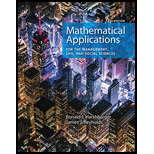
Concept explainers
Fish species growth For many species of fish, the weight W is a function of the length L that can be expressed by
Suppose that for a particular species k = 0.02, that for this species the length(in centimeters) is a function of the number of years t the fish has been alive, and that this function is given by
Find
Want to see the full answer?
Check out a sample textbook solution
Chapter 1 Solutions
Mathematical Applications for the Management, Life, and Social Sciences
- Radioactive Decay The half-life of radium-226 is 1590 years. (a)If a sample has a mass of 150 mg, find a function that models the mass that remains after tyears. (b)Find the mass that will remain after 1000 years. (c)After how many years will only 50 mg remain?arrow_forwardGrowth in Length of Haddock D.S. Raitt found that the length L of haddock in centimeters as a function of the age t in years is given approximately by the formula L=5342.820.82t a. Calculate L(4) and explain what it means. b. Compare the average yearly rate of growth in length from age 5 to age 10 years with the average yearly rate of growth from age 15 to age 20 years. Explain in practical terms what this tells you about the way haddock grow. c. What is the longest haddock you would expect to find anywhere?arrow_forwardGrowth in Weight and Height Between the ages of 7 and 11 years, the weight w, in pounds, of a certain girl is given by the formula w=8t. Here t represents her age in years. a. Use a formula to express the age t of the girl as a function of her weight w. b. At what age does she attain a weight of 68 pounds? c. The height h, in inches, of this girl during the same period is given by the formula h=1.8t+40. i. Use you answer to part b to determine how tall she is when she weighs 68 pounds. ii. Use a formula to express the height h of the girl as a function of her weight w. iii. Answer the question in part i again, this time using your answer to part ii.arrow_forward
- Marine Fishery One class of models for population growth rates in marine fisheries assumes that the harvest from fishing is proportional to the population size. For one such model, we have G=0.3n(1n2)0.1n Here G is the growth rate of the population, in millions of tons of fish per year, and n is the population size, in millions of tons of fish. a.Make a graph of G versus n. include values of n up to 1.5 million tons. b.Use functional notation to express the growth rate if the population size is 0.24 million tons, and then calculate that value. c. Calculate G1.42 and explain in practical terms what your answer means. d.At what population size is the growth rate the largest?arrow_forwardPopulation The table shows the mid-year populations (in millions) of five countries in 2015 and the projected populations (in millions) for the year 2025. (a) Find the exponential growth or decay model y=aebt or y=aebt for the population of each country by letting t=15 correspond to 2015. Use the model to predict the population of each country in 2035. (b) You can see that the populations of the United States and the United Kingdom are growing at different rates. What constant in the equation y=aebt gives the growth rate? Discuss the relationship between the different growth rates and the magnitude of the constant.arrow_forwardThe table shows the mid-year populations (in millions) of five countries in 2015 and the projected populations (in millions) for the year 2025. (a) Find the exponential growth or decay model y=aebt or y=aebt for the population of each country by letting t=15 correspond to 2015. Use the model to predict the population of each country in 2035. (b) You can see that the populations of the United States and the United Kingdom are growing at different rates. What constant in the equation y=aebt gives the growth rate? Discuss the relationship between the different growth rates and the magnitude of the constant.arrow_forward
 Functions and Change: A Modeling Approach to Coll...AlgebraISBN:9781337111348Author:Bruce Crauder, Benny Evans, Alan NoellPublisher:Cengage Learning
Functions and Change: A Modeling Approach to Coll...AlgebraISBN:9781337111348Author:Bruce Crauder, Benny Evans, Alan NoellPublisher:Cengage Learning Big Ideas Math A Bridge To Success Algebra 1: Stu...AlgebraISBN:9781680331141Author:HOUGHTON MIFFLIN HARCOURTPublisher:Houghton Mifflin Harcourt
Big Ideas Math A Bridge To Success Algebra 1: Stu...AlgebraISBN:9781680331141Author:HOUGHTON MIFFLIN HARCOURTPublisher:Houghton Mifflin Harcourt
 Trigonometry (MindTap Course List)TrigonometryISBN:9781337278461Author:Ron LarsonPublisher:Cengage LearningAlgebra & Trigonometry with Analytic GeometryAlgebraISBN:9781133382119Author:SwokowskiPublisher:Cengage
Trigonometry (MindTap Course List)TrigonometryISBN:9781337278461Author:Ron LarsonPublisher:Cengage LearningAlgebra & Trigonometry with Analytic GeometryAlgebraISBN:9781133382119Author:SwokowskiPublisher:Cengage Algebra and Trigonometry (MindTap Course List)AlgebraISBN:9781305071742Author:James Stewart, Lothar Redlin, Saleem WatsonPublisher:Cengage Learning
Algebra and Trigonometry (MindTap Course List)AlgebraISBN:9781305071742Author:James Stewart, Lothar Redlin, Saleem WatsonPublisher:Cengage Learning





